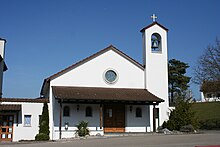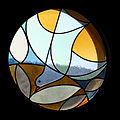St. Josef (Rickenbach Sulz)
The St. Josef Church is a Roman Catholic church, which is located in the Sulz district of the Rickenbach ZH municipality in the Winterthur district of Zurich . It was the first Catholic church north-east of Winterthur , which had been built in that area since the Reformation . Until 1981 it was also the parish church of today's parish of St. Stefan Wiesendangen .
history
History and naming
Until the Reformation, the inhabitants of today's Canton of Zurich were Catholic. The Reformation was carried out in the city of Zurich in 1524, which is why Catholic worship was prohibited in the area of today's Canton of Zurich until the 19th century. The Edict of Tolerance of 1807 allowed a Catholic worship service in the canton of Zurich for the first time, but only in the city of Zurich. In 1813, 50 Catholics living in the city of Winterthur appealed to the city fathers for tolerance , but it was not until 1862, when the Rheinau monastery was abolished and the further use of its property was legally regulated by the canton of Zurich, that the first Catholic service was allowed in Winterthur have taken place since the Reformation. The so-called First Zurich Church Law from 1863 recognized Zurich as well as the Catholic parishes in Winterthur, Rheinau and Dietikon (the last two were traditionally Catholic places), so that a Catholic parish could be established in Winterthur. In 1868 the newly built St. Peter and Paul Church was opened in the presence of representatives of the cantonal government, including state clerk and poet Gottfried Keller, and the city council of Winterthur. However, the establishment of further parishes in the canton was not recognized by the state, which is why these had to be set up on the basis of private and association law.
Development and construction history
In the course of industrialization , working-class families from Catholic countries moved to the canton of Zurich. Since the Catholic churches in the traditionally reformed canton only lived sporadically, long distances had to be covered for the worship service. The Catholic residents of the communities northeast of Winterthur were looked after by the parish of St. Marien Oberwinterthur . When the desire for their own church services grew, a separate pastoral district was set up for the Catholics in the parishes near Rickenbach and Seuzach , which, however, remained affiliated with the parish of St. Marien in Oberwinterthur. In the same year, the first mass in the new pastoral care district was celebrated in the restaurant zur Mühle in Rickenbach. In 1956 the building site for the church St. Josef in Sulz was bought, on which at that time there was an old barn. There the Catholics built the church with a lot of personal effort and thanks to a loan from the domestic mission in the years 1957-1958, which was consecrated on May 18, 1958 by Canon Franz Schnyder, who was also the director of the domestic mission. After the state recognition of the Catholic Church in the canton of Zurich in 1963, the Catholic parish Rickenbach-Seuzach was founded with the political communities Altikon , Bertschikon , Dägerlen , Dinhard , Ellikon an der Thur , Elsau , Hettlingen , Rickenbach, Seuzach, Thalheim , Wiesendangen . The St. Josef Foundation was founded in 1966 to promote pastoral care, church services, religious instruction and charitable interests in Sulz-Rickenbach . In 1968 the Rickenbach-Seuzach parish rectorate was set up, which remained attached to the St. Marien parish in Oberwinterthur. St. Martin in Seuzach and St. Josef in Sulz-Rickenbach were raised to independent parishes in 1972 and separated from St. Marien Oberwinterthur. In the following year, the building site for the St. Stefan church was bought in Wiesendangen. In 1981 the St. Stefan Church in Wiesendangen was consecrated. At the same time the parish office moved from Sulz-Rickenbach to Wiesendangen and the parish was renamed St. Stefan. In 1983 the Church of St. Joseph in Sulz was renovated and redesigned according to the requirements of the liturgy constitution of the Second Vatican Council . On May 8, 1983 Vicar General Gebhard Matt consecrated the people's altar .
The parish of St. Stefan Wiesendangen belongs together with the parish of St. Martin Seuzach to the common parish. With 5,936 members (as of 2017), this is one of the larger Catholic parishes in the Canton of Zurich.
Building description
Church tower and exterior
The St. Josef church is located in Rickenbach in the Sulz district at Stationsstrasse 20, a little set back from the street. The fact that the St. Joseph Church was built with little money and a lot of personal work is evident from its simple exterior. It is a simply designed church building with a gable roof . A small church tower is built on the front, in which there is a bell in the open belfry. This bell is the old St. Arbogast bell of the Church of St. Marien Winterthur-Oberwinterthur, which passed this bell on to the Church of St. Josef after receiving a new bell. A canopy protects the worshipers from the weather. To the left of the church is the rectory, in which there is also a parish hall. When structural defects appeared in the St. Josef Church in the 1970s, the Board of Trustees decided in 1980 to subject the property with church and rectory to a comprehensive renovation, which was carried out by the architect H. Schmidt. A uniform ensemble was created, which takes into account the needs of the community, especially through the enlarged parish hall.
Interior and artistic equipment
In the course of this renovation work at the beginning of the 1980s, the church choir was completely redesigned and the church interior was adapted to the liturgy of the Second Vatican Council . The windows were designed by the painter Jacques Schedler . In the nave, like skylights, they show the symbols of the Way of the Cross . Central elements of Good Friday are shown : Jesus' flagellation is shown in the first window on the left, followed by the crown of thorns , the vinegar and the dice with which the soldiers played about the dress of Jesus. On the right, the betrayal of Peter by the rooster is indicated. It is followed by the nails with which Jesus was nailed to the cross, the sponge with which Jesus was given vinegar to drink and finally the INRI symbol, which refers to the royal dimension of Jesus. Two more windows are hidden behind the parapet of the organ gallery. On the way up to the organ there is a representation of Jerusalem , on the opposite side the curtain of the temple, which was torn at the moment of Jesus' death. If the windows in the nave are kept in red tones, the dominant color of the three-part choir window is blue. Since this window is easted, sunlight floods through this window in the morning, which depicts the resurrection of Christ and thus contrasts the Good Friday story with the Easter story . The rose window above the church portal shows the Holy Spirit represented as a dove. On the left side of the church portal there are two more glass windows by Jacques Schedler, which refer to the Eucharist with the motifs of grapes, grain and bread . In addition to the glass windows that characterize the interior of the church, there are other equipment elements, such as the wooden cross with body in the choir, the carved figures of Mary with the child and Joseph, the Stations of the Cross by Karl Ruff and the tabernacle with the inscription «God is there ». These elements come from the time the church was built. The church organ is an instrument made by the organ building company Späth , Rapperswil. This was built into the gallery parapet in 1981.
literature
- Episcopal Ordinariate Chur (ed.): Schematism of the Diocese of Chur. Chur 1980.
Web links
Individual evidence
- ^ Peter Niederhäuser and Flurina Pescatore: St. Peter and Paul. The mother church of Katholisch-Winterthur. Pp. 7-17.
- ^ Website of the parish of St. Stefan, section history. ( Memento from May 2, 2014 in the Internet Archive )
- ^ Archives of the parish.
- ↑ Catholic Church in the Canton of Zurich (Ed.): Annual Report 2017. p. 84.
- ^ Website of the parish of St. Stefan Wiesendangen, section Architecture and Art in the Church of St. Josef. ( Memento of the original from May 2, 2014 in the Internet Archive ) Info: The archive link was inserted automatically and has not yet been checked. Please check the original and archive link according to the instructions and then remove this notice. Retrieved March 27, 2014.
Coordinates: 47 ° 32 '18.6 " N , 8 ° 47' 21.6" E ; CH1903: seven hundred and one thousand six hundred and ninety-four / 266 183




















